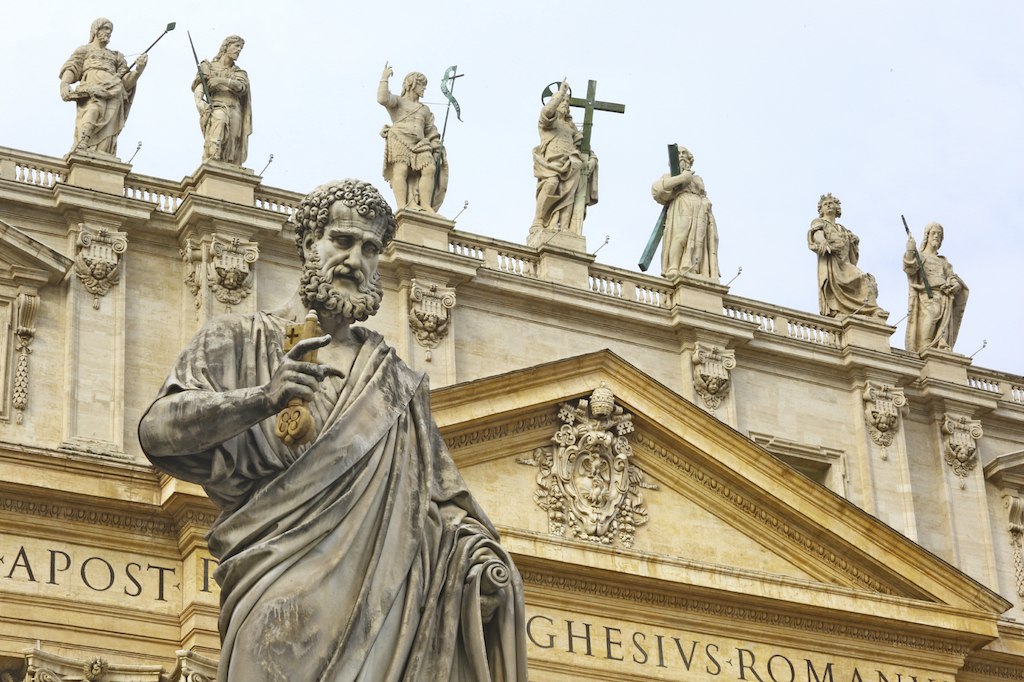Do you know the 4 marks of the Catholic Church? You probably do, although perhaps you’ve never heard them called that. We state the 4 marks every time we pray the Nicene Creed: we are one, holy, catholic and apostolic. Let’s look at each of these terms.
First, we are one church. Author Kevin Whitehead says that the meaning of one church was vital to the new church formed by the Apostles:
The Church of the apostles was definitely one: “There is one body and one spirit,” Paul wrote, “just as you were called to the one hope that belongs to your call, one Lord, one faith, one baptism, one God and Father of us all” (Eph. 4:4-5). Paul linked this primitive unity to the Church’s common Eucharistic bread: “Because there is one bread, we who are many are one body, for we all partake of one bread” (1 Cor. 10:17). Jesus had promised at the outset that “there would be one flock, one shepherd” (John 10:16).
We remain so today. Under the guidance of the bishops and the pope, our faith is unified. For instance, you can attend a Mass in Ireland, in South Africa, in Alaska, in Peoria and the Mass remains the same. Even if you do not speak the local language, you understand what is happening. Most important, Christ is present Body, Blood, Soul and Divinity at every Mass.
The next mark of the Church is holy. Does this mean that each and every Catholic is holy? Unfortunately no. The Church is a holy institution made up of sinners. The Church is holy because Christ is holy. Fr. William Saunders:
Christ sanctifies the Church, and in turn, through Him and with Him, the Church is His agent of sanctification. Through the ministry of the Church and the power of the Holy Spirit, our Lord pours forth abundant graces, especially through the sacraments. Therefore, through its teaching, prayer and worship, and good works, the Church is a visible sign of holiness.
Nevertheless, we must not forget that each of us as a member of the Church has been called to holiness. Through baptism, we have been freed from original sin, filled with sanctifying grace, plunged into the mystery of our Lord’s passion, death, and resurrection, and incorporated into the Church, “the holy people of God.” By God’s grace, we strive for holiness.
For lay people, we have a responsibility to become holy. Holiness is not something meant for “those” people: priests, nuns, that little old lady who goes to Mass every day and sacrifices a great deal to support the Church financially. No, it is our responsibility to seek holiness in whatever place we find ourselves. If you are a nurse, God wants you to be a holy nurse. If you are a farmer, God is calling you to be a holy farmer. If you run a cash register at a restaurant, God wants you to be holy in that job. And of course, we are all called to be holy in the context of our families.
The word catholic in the Creed often throws people off. Some think that it’s the name of our church. We are known as Catholics; we belong to the Catholic Church. But in the Creed, this word means something a bit deeper. Catholic here means universal. Think about it: Christ called his Apostles and disciples to “go and make disciples of all nations.” And they did. Our Church still does. Our Church serves the needs of people around the world. This means that we don’t simply belong to St. Martin de Porres Church down the street; we belong to a universal church that covers the globe. Anywhere there is a Catholic Church, we are home.
Finally, the mark apostolic. Just as one might imagine, this has to do with the Apostles. Christ Himself appointed the leaders of the early Church: his Apostles. Yes, He was clearly aware of their faults, their doubts, their sins. Yet, Christ still told them they were to lead the Church.
The apostles were the first bishops, and, since the first century, there has been an unbroken line of Catholic bishops faithfully handing on what the apostles taught the first Christians in Sacred Scripture and Sacred Tradition (2 Timothy 2:2). These beliefs include the bodily Resurrection of Jesus, the Real Presence of Jesus in the Eucharist, the sacrificial nature of the Mass, the forgiveness of sins through a priest, baptismal regeneration, the existence of purgatory, Mary’s special role, and much more – even the doctrine of apostolic succession itself.
As Catholics, we do not bear this marks on our physical being, like some sort of tattoo. However, we do bear them indelibly in our souls because of our baptism. And since we proclaim our belief in these 4 marks of the Church when we pray the Creed, we certainly ought to know what they mean, not just for the Church, but for us. We are meant to be unified with all Catholics, called to be holy, to know that our Church is universal and not simply our local parish or diocese, and that we have pledge (through baptism, the reception of the Eucharist, and our confirmation) to follow the teachings of our bishops and the Pope, so long as none of those teachings defy the Magisterium of the Church.
Most of us will not have the 4 marks of the Church tattooed on our bodies, but they should always be tattooed on our hearts.
